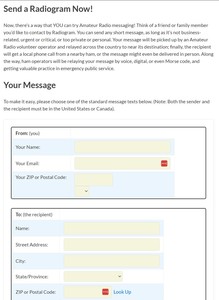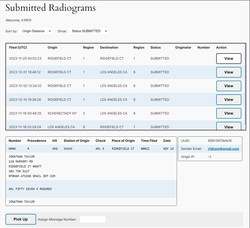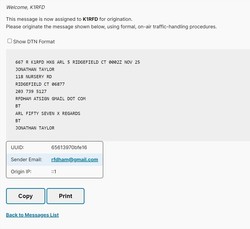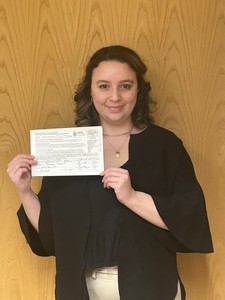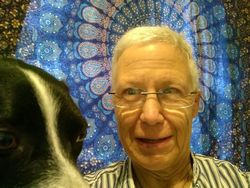 January 3, 2024 | |||||||
NTS 2.0 Update: A Radiogram Portal Jonathan Taylor, K1RFD The Working Group on Updated Access and Delivery Methods has been putting the finishing touches on a project called The Radiogram Portal.
It's a new website that introduces Radiograms to the general public and provides an easy way for the public to submit messages that can be originated as formal traffic. The Portal has two goals in mind: First, to explain what amateur radio messaging is all about, to an audience that might not be familiar with Radiograms - or for that matter, amateur radio in general. And second, to provide a quick and easy way to boost the volume of true third-party traffic into NTS.
Here's how it works: Someone, typically a non-ham, discovers the Radiogram Portal home page on the web, and fills out a simple form to compose a message to send to a friend or relative. The message is stored in a special database that also tracks the NTS region in which the submitter lives. Any volunteer traffic handler who has registered in advance to pick up traffic from the Portal, can visit the site from time to time to look for newly submitted messages.
Finding one, he or she clicks "Pick Up," the site converts the message to standard Radiogram format, and the volunteer traffic handler then originates the message into NTS in the usual way using any available mode -- phone, digital, or CW. From there, the message makes its way to its destination and final delivery.
Editor's note: This exciting program is currently being tested before being opened to the ham community and the public. Stay tuned. Treasure Hunt Coming in February 2024 We're pleased to announce that the first Annual NTS Treasure Hunt will kick off in February 2024! You'll find the first clue in the February issue of The NTS Letter. Please see the December issue at https://www.arrl.org/nts-letter?issue=2023-12-05#toc05 for details. New VE Package Proposed The NTS 2.0 Access & Delivery Working Group has recently taken on a new task: Developing a package of materials that a Volunteer Examiner (or a VE team) could distribute to a newly licensed amateur to encourage them to participate in the National Traffic System and check into local traffic nets. It's thought that such information could be invaluable to the new ham, who often starts out with nothing more than a handheld radio and the name of a local radio club. They typically have no information about operating activities.
"I can't think of a better activity in which a newly licensed Technician can become involved than a VHF traffic net," writes ARRL New England Division Director Fred Kemmerer, AB1OC. "It's something where a new ham can check into a daily net and learn important skills -- like handling formal, written traffic; learning proper phonetics; net procedures and net discipline -- the same skills that a new operator needs to know in order to participate in emergency communications and ARES operations." The "NTS VE Package" will convey to the new amateur the enjoyment factor of traffic handling, as well as the valuable skills they will learn to progress in their ham career. The materials would be downloaded from ARRL's website by Volunteer Examiners, then printed and handed out at the conclusion of an exam session. This material, along with the upcoming release of the new Online Net Directory, would provide the newcomer with times and frequencies of local nets. Radiogram Deliveries: A Vital Part of Message Handling I think we can agree that we traffic handlers do what we do because we enjoy it. We enjoy the camaraderie of the nets, the satisfaction of being able to copy and accurately relay a radiogram on its way to destination. Yet unfortunately all too often we hear about those radiograms that were never delivered. There could be legitimate reasons, such as an inability to reach a recipient. Some have wondered however if it may be complacency. I have heard from several readers about their experiences in delivering radiograms, the excitement on the part of the recipient, or an introduction to traffic nets and message handling that ultimately produced new traffic handlers. I would like to share with you some of their positive experiences. ARRL Wisconsin Section Manager Jason Spetz, KC9FXE, writes: "I've been following the recent discussion on radiogram messages and thought I'd share this response that came back from a non-ham recipient of a birthday greeting. I assisted a local ham in getting his message into the system. Of course, he was thrilled to hear this back from the recipient... Great work by the operator who made sure the message was delivered!" "I received a FANTASTIC ARRL RADIOGRAM happy birthday greeting from you! The AMAZING operator Stephen Hawes in Berkeley, CA, WB6UZX, took the time to US MAIL an EXTREMELY COOL typed radiogram, saying, 'I tried to deliver this message via telephone, but your answering machine blocked me. Sorry for the delay.' It was just INCREDIBLY nice of him to pass on your message!! Truth be told, I don't have any blocking on my phones, so I'm not sure what happened. However, the wonderful part is it all worked out way better! I am SO grateful that he took the time to create the paper radiogram and mail it - I'm so old fashioned, I'm actually happier having a piece of paper to save and continue making me smile! I will definitely let him know how much I appreciate his effort -- really, really means a lot to me.' Ray Webb, KB8GUN, writes, "Some of us in the amateur community are traffic handlers, and we perform those duties on a day-to-day basis. We pick up traffic by various means, and we pass it along to stations who make the final delivery. We do this time after time, and we get very comfortable with that regular routine. We have been at this for so long, we often forget what it was like when we were newbies, the ink still wet on the license, and we were still wet behind the ears, as they say. We then get a piece of traffic that we need to deliver ourselves. We dial the number of the recipient, and then the magic happens. I often hear, 'What is a radiogram?' Often followed by, 'I can't believe that someone is sending me a message.' You can hear the excitement and joy in the voice of the newly licensed ham. Thank God it is contagious, and we keep doing it. Thank God there are people like NX9K and N9VC that take the time to generate the 'welcome to amateur radio messages.' The new hams are grateful that people took the time to welcome them to the hobby. We get complacent when we forget what those voices of gratitude and joy sound like." "I recently had the privilege of working some future hams during a Jamboree On The Air event. The contacts were all third party, and I could hear the sound of the radio bug biting a few of them. I got the bug myself when, to my surprise, QSL cards from that event started showing up in my mailbox. The spelling wasn't always accurate, the penmanship was not neat, but they are now some of my most prized possessions. I can't wait to work them again!! That is why we keep doing this on a daily basis. Joy and happiness are highly contagious, and we all need to do our best to spread that around. Always try to express a positive demeanor and tell your radiogram recipients, on behalf of ARRL, 'Welcome to Amateur Radio!!'" Jim Batka, N9VC, -- who along with wife Kris, NX9K, sends radiograms to newly licensed hams welcoming them to the hobby -- receives very positive responses to their efforts. He includes a few of them here: THANKS VERY MUCH FOR WELCOME MESSAGE 6698 X AM VERY EXCITED TO GET ON THE AIR 73 MESSAGE 6731 ... TALKED WITH HIS MOM X SHE IS VERY PROUD OF HER SON THANK YOU FOR THE WELCOME MESSAGE IM LOOKING FORWARD TO EXPLORING MY NEW HOBBY 73 THANK YOU FOR YOUR WELCOMING MESSAGE 73 ARL FORTY SEVEN ... ERIC SAID AWESOME AND THANKS FOR THE MESSAGE 73 ARL SIXTY ONE THANK YOU FOR YOUR COMMITMENT TO THE TRAFFIC SYSTEM X BEEN A PLEASURE WORKING WITH YOU THIS YEAR 73 In my own Section we recently gained a new traffic handler because an ORS delivered a welcome to amateur radio radiogram by US mail to a newly licensed ham. A few weeks later, he heard that radiogram recipient on a local net handling practice traffic. He called the new ham on the air to congratulate him for getting involved in NTS and was told it was that radiogram that got him involved. That ORS, Shawn, N1CVO, says that even though the message had an HXG handling instruction, he considered the cost of a stamp a part of the hobby. "That's just me," he said. One of the goals of the NTS 2.0 team is to improve upon deliveries. Taking a positive attitude toward the importance and excitement of message deliveries could go a long way. It may even make our day. It did mine. CW Traffic Nets CW traffic nets have been around for a long time and were very popular 50-60 years ago. However, due to the FCC dropping the CW requirement for licensing, and perhaps more so to the increasing interest in digital communications, CW nets have lost some of their appeal. They are still very much around, although with fewer participants. Some Sections may have no CW nets at all. The evening NTS nets run almost exclusively via CW, but generally are not slow enough for newcomers to follow. There are slow speed nets, but knowing how to find one can be a problem. Why would anyone be interested in CW nets? It takes effort to learn CW. Plus, the growth of digital communications has great appeal, especially to younger hams. I would be interested in hearing from CW traffic handlers regarding what it has meant to you. For me, it's just plain fun. It's like being able to "speak" another language. Traffic nets give meaning to my skills as a CW operator when I can copy a radiogram and successfully relay it on toward its destination. Traffic handling and traffic nets motivated me to upgrade my license and gave me a great sense of accomplishment. Knowing CW and having experience in CW traffic handling could even be a much-needed asset in an emergency where no internet exists, and available computers and voice communications are iffy at best. It is a known fact that a CW signal cuts through poor propagation far better than a modulated voice signal. But how does one gain proficiency in CW traffic handling? Obviously, training is necessary. Once it becomes available, the ARRL on-line net directory will contain information on slow speed and training nets. Perhaps your section has a training program on CW message handling. I have heard about training via Zoom in some areas. The NTS 2.0 folks are developing training videos which should be available early in 2024. Check nts2.arrl.org for updates. Meanwhile you might also check out the Long Island CW Club, which is currently offering a training program via Zoom in NTS CW traffic nets. Membership in the club is required, and costs around $30 but has many benefits. Visit their website at https://longislandcwclub.org, or contact Ed Conway, N2GSL, for details. Spotlight: K6HTN Laura K. Hutton, K6HTN, commonly known as "Kate," has been well known for some time to traffic handlers throughout the country as one of the earlier creators of the modern-day "Welcome to Amateur Radio" radiograms. While she has recently cut back on some of this activity, very few traffic handlers (if any) have not delivered at least one of her radiograms. I suspect several recipients were introduced to message handling and NTS because of Kate.
As a student at Caltech University, Kate was introduced to amateur radio but delayed getting a license until 2008. While employed at Caltech as a seismologist she became involved in the first Great California ShakeOut earthquake exercise. She says although all communications were supposedly compromised, two undergrad students -- members of the Caltech Amateur Radio Club -- let it be known they could talk to any county EOC in southern California. This was not only her introduction to ham radio but also to formal message traffic. Three months later, she had her Technician-class license, followed a few months later by a General-class ticket. One of the two primary aspects of the hobby that piqued her interest was CW or Morse code, something she had not found time to learn previously. Joining an online site, she learned enough to get on the air and contacted another CW operator. The other aspect piquing her interest was traffic handling and the National Traffic System. After joining the CW organization FISTS, she received a radiogram welcoming her to the organization. The delivering ham invited her to a local NTS net, where she was then mentored by her Elmers: KI6BHB, K6IFF (SK), K6YR, and K9JM. Since then, Kate has "paid it forward." In addition to serving as Section Traffic Manager for the Los Angeles Section, and after bolstering her own CW skills with the help of the CWops CW Academy, she became a mentor for that organization, helping others to learn and use this older but reliable means of communication. When asked why one would want to become involved in CW traffic nets in this age of digital communications, she says, (1) some operators like it, (2) live code practice, (3) we get to welcome new hams to the hobby, to a club, send seasonal greetings, etc. via a traditional, "steampunk" method, and (4) the "when all else fails" mentality, something that happened as recently as 2018 during a Puerto Rican hurricane when a large number of welfare messages were passed between two Puerto Rican hams and amateurs on mainland US. In addition to ham radio, Kate keeps busy with her dogs, a Border Collie and two Blue Heelers. She works part time for a puppy preschool. NTS Resources The National Traffic System® (NTS) is a network of amateur radio operators who move information during disasters and other emergencies. General messages offering well wishes also move through the NTS to help test the system and to help amateur radio operators build traffic handling skills. While the NTS is primarily set up to serve the United States and Canada, it is possible to move traffic internationally through the NTS through various local, regional, area, and international network connections.
Sign up to Receive The NTS Letter The NTS Letter is published monthly and is free of charge to ARRL members. Subscribe: arrl.org/opt-in-out Editor: Marcia Forde, KW1U, Section Traffic Manager -- Eastern Massachusetts, Western Massachusetts, and Rhode Island ARRL Director of Emergency Management: Josh Johnston, KE5MHV ARRL Emergency Management Planner: Jeremy Dunkley, KC1SIV Support NTS: Join ARRL NTS is a program of ARRL The National Association for Amateur Radio®. No other organization works harder than ARRL to promote and protect amateur radio! ARRL members enjoy many benefits and services including digital magazines, e-newsletters, online learning (learn.arrl.org), and technical support. Membership also supports programs for radio clubs, on-air contests, Logbook of The World®, ARRL Field Day, and the all-volunteer ARRL Field Organization.
| |||||||
